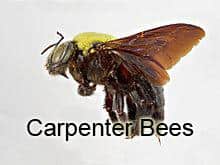Call Us Now: 330-832-4642 | 330-494-8873

Size: 1/2 to 1 inch
Color: Shiny black and yellow
Where found: Dead wood, bamboo, wood structures
Potential treatment: Exterior Spray
Carpenter bees are large bees, 1/2 to 1 inch long, and are often mistaken for bumblebees because of their size and markings. They actually are a bit larger than bumblebees and their abdomens are a shiny black, whereas a bumblebee's body is covered with hair.
They are found throughout the United States in all climates, and get their name because of their tendency to nest in dead wood, bamboo or wood structures. A carpenter bee nest is readily identifiable by its perfectly round hole bored into wood, usually just large enough for the bees to pass through.
Carpenter bees survive on flower pollen and nectar gathered by the females in the colony. Their constant search for this food makes these bees important pollinators for flowering plants and growing vegetables. They do not eat the wood removed to create their nests, but will often reuse it to create partitions and cells for development of their young.
A carpenter bee nest is series of tunnels bored into wood by the vibrating body of the bee. The nest has only one entrance and the tunnels usually are near the surface of the tree or structure, so structural damage from a carpenter bee nest is typically minimal compared to that done by carpenter ants or termites.
Male carpenter bees are often seen hovering near their nests, but while the bees may seem to be guarding or protecting the nest, they do not have stingers and are harmless. Females do have stingers, but generally become aggressive only when provoked.
Carpenter bees live for about one year. They are somewhat social, and males and females do mate. Females lay eggs in late spring. The eggs hatch quickly and the young feed on pollen until they become adults in about two months. Males die soon after mating, while the females may die after laying eggs or may last through the summer. The newly hatched bees hibernate in the winter in their existing nests, but become active mating and building new nests soon after the spring thaw.